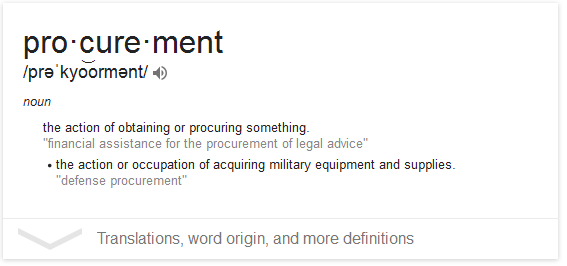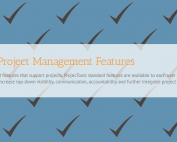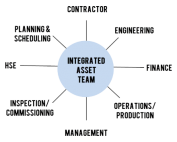Let’s Define Procurement
Define Procurement
A quick google search defines procurement.
While obvious, this procurement definition is lame. It would get our consultants laughed at if they were to put this on a slide in a meeting. I suppose that’s ok if its display was intended as a joke. But let’s be honest – while military procurement may a joke, no one’s laughing
In the project world that ProjecTools lives in, procurement is the indispensable, months or years long struggle to obtain equipment, supplies, and services as designed and approved; and to deliver those efficiently, and in a state to operate safely, to the client on time and on budget. That’s how we define procurement at ProjecTools. The definition isn’t catchy. It isn’t academic – or complicated. It’s just a quick and dirty way to define procurement as we live it.
For folks in engineering, EPC, or construction, this definition of procurement will ring true. Everybody understands and shakes their head knowingly when we rattle off our definition. While the knowing nods say a lot, it goes unsaid that each group or player in our definition of procurement probably executes it differently. These different processes define procurement for any individual company. The strengths and weaknesses, and wide variations in the execution of the procurement processes keep ProjecTools inspired and happily engaged in the procurement business.
If our definition of procurement rings true for your business, it is worth thinking about the components that are at work in it. To help you flesh out your company’s definition of procurement we will start with the procurement definition and examine its parts.
Let’s start with Procurement is indispensable. At ProjecTools, we are selective in our role model choices. We love Stephen R Covey (Seven Habits of Highly Effective People). A key Covey principle of Covey is “The main thing is to keep the main thing the main thing”. Simple, but certain. Procurement is a main thing made up of many upstream main-thing components and downstream main-thing components that must be treated as the main thing for each owner of each component at each critical time. Without procurement, products would never proceed past the idea or engineering phase. Without raw materials, assembly machines, tools, computers, internet, steel, paint, buildings, software, engineering paper, etc. no EPC company (or any company) would ship a single product. And you no-doubt expect each step in your supply chain to treat your order with the respect and care due the main thing.
At a less philosophical level, the procurement definition checks out, too. EPC projects are Engineering, Procurement, and Construction by definition. Without procurement you have engineering – which is ok actually. In fact most EPC companies start out as Engineering companies and grow into EPC companies, adding procurement and construction sometime later. They are driven to vertically integrate downstream processes into the business model because EPCs get the biggest contracts, the most control over the execution of the project, and the glory and recognition at the end of the project. Since success begets success, the EPC continues momentum winning more projects as their resume grows.
The next component as we define procurement is a months or years long struggle. This timeline is literal, especially in the EPC industry’s definition of procurement. Building a bridge, power plant, skyscraper, or offshore production asset can take years. These are millions or billions of dollar projects that take time, thought, and often global teams to produce. The struggle is real too. In a high stakes EPC project, there are often hundreds or thousands of people involved. Engineers, managers, schedulers, cost controllers, HSE teams, commercial teams, quality surveillance teams, logistics teams, document controllers, auditors, regulators, construction teams, inspection/completions teams, partners, consultants, and clients are trying to coordinate and measure progress and performance for years on end. Unfortunately the makeup of a project team evolves over the life of the project. People come, people go. Market conditions change over the life of the project. Copper prices climb, oil prices plummet. Requirements change over the life of the project. 4 elevator banks changes to 6.
The struggle isn’t dealing with these changes or keeping the good people that work these projects on task. The struggle is coordinating these groups, balancing their competing priorities and directives for years at a time while managing the changes and typical factors that derail a project. Understanding and responding to the duration and struggles in the EPC procurement definition is absolutely paramount to profitable procurement execution. In fact, the companies that demonstrate understanding and mastery of this struggle tend to deliver higher quality and meet client expectations more reliably, which leads to more repeat procurement business, more independence, and bigger contracts.
The third part of the procurement definition is to obtain the equipment, supplies, and services. This may seem like the most obvious part of the procurement definition. While obvious, this is not always a simple feat. Obtaining equipment, supplies and services sometimes requires substantial expenditure which opens companies up to substantial risk. Good procurement departments understand this and actively work to mitigate procurement risk. This means working with engineering to produce the most complete and specific technical definition for equipment, working with suppliers to ensure competency, working to provide the most specific commercial terms, and working actively with other groups (suppliers, logistics, quality surveillance, construction, scheduling, cost controllers) to eliminate unknowns.
Along with developing specifications and eliminating unknowns, Procurement for EPC has a duty to ensure these teams work together effectively. This means each group needs access to the latest information and appropriate communication media. This may seem like a simple task. In fact most procurement departments figure that if somebody needs information or has questions – they will simply ask. By overlooking strategies to improve collaboration among the contributing groups, the procurement process struggles to centralize documents, process approvals, gather bids, and issue POs in a timely manner. This struggle in most cases is not because any one team or player is incompetent, rather teams spend too much time chasing paper which extends the process.
The next part of the procurement definition is to deliver safely functioning products. This may seem like a no-brainer as well, however there are a few meanings hidden in this part of the procurement definition. The first is to deliver products that function. Fair enough. The second is to deliver a product that functions safely. The third is to deliver a product safely – unharmed from transport, packaging, and receiving.
To deliver functioning products, procurement teams must rely on engineers to design quality products and the suppliers to build those quality products. Obviously, engineering documents must be reviewed by internal teams, suppliers, and clients. Consensus on proper and specific design is key. There should be little room for improvisation on the supplier side and confidence in the design on the client side. While not every procurement department will manage the process of gaining consensus, they should be assured of it. Further, procurement departments should be involved in the quality surveillance plan. The quality surveillance plan should be cost effective, thorough, and execution should be documented religiously. Proper quality surveillance inspections will ensure the equipment is built to spec and on schedule.
To deliver products that function safely, procurement teams should be aware of the HSE implications of the product. The HSE concerns should be incorporated into the quality surveillance plan. In the current economic environment that values social responsibility and is quick to litigate, there is no tolerance for unnecessary workplace hazards. This is true for the fabrication, transportation, installation, and operation of all requisitions. In other words, safety is everybody’s responsibility, even the procurement department’s.
Few situations are more demoralizing than brand new equipment arriving late, to the wrong jobsite, or damaged during transport. To deliver products safely, Procurement departments enlist logistics specialists. Logistics specialists should be tightly integrated with procurement teams. This means logistics teams should have access to relevant PO data and a controlled media to interface with the upstream technical and commercial teams (ie. Engineering and Procurement).
Finally, to deliver products safely in a timely manner, which is the final component of the Procurement Definition, logistics teams should be able to interface with suppliers (obviously), receiving, and construction teams. Communication channels with these teams should be readily accessible, recorded to each PO, and under no circumstance rely on ad-hoc emails. Logistics teams relying on emails can be dangerously inefficient and ineffective at achieving their goals. It is worth mentioning that these shortfalls are not because of incompetence, rather, shortfalls of emails as a communication medium.
Keep these principles in mind as you define procurement for your industry or company. Defining procurement for you is as simple as taking a step back from the day to day processes and strategies to look at the overall objective. Through exploring our definition of procurement for the EPC and capital construction industries, I not only have an escalated appreciation for the complexity of procurement and the value it brings, but the procurement professionals that continue to elevate the profession.
ProjecTools Product Information
ProjecTools Client Spotlight
ProjecTools Client Spotlight "I don't see how companies can manage projects like [...]
Standard Project Management Features
ProjecTools subscriptions provide valuable standard features that support projects. ProjecTools standard features are available to each user to complement core application functions and business processes. Utilize the modules below to increase top-down visibility, communication, accountability
Security and Reliability
Users need a secure, reliable environment to access project information and perform work. All applications and client data resides in a private cloud network with data replication and failover to geographically diverse datacenter equipment. ProjecTools provides 99.5% Network Availability
Construction Project Management Services
ProjecTeams is proven for flexible on-site or remote project deployments. Each ProjecTeam specialist has deep work history with a career of improving project execution, information management processes, with tools that make projects efficient, timely, and profitable.
ProjecTools Resources
Spreadsheets and Email as Project Management Tools
Projects have too many moving parts and too many players to be trusting critical data to spreadsheets and emails. You need a spreadsheet reduction strategy.
Project Management Assessment
Project Management Assessment Assess your project management practices against the best project execution teams in the Capital Construction, [...]
Document Management Software ROI
Document management is massively important for engineering and construction projects. Take the approach and use the tools that add the most value.
Aligning Document Control and Cost Control
Align Document Control with Cost Control and create seamless progress and earned value reports to stay on budget and improve cash flows.
ProjecTools Videos, Demos, and Webinars
Optimizing Review and Approval Processes for Engineering
Let’s talk about review and approvals, and closed-loop systems, and how to execute the review and approval processes for engineering and commercial...
The Keys to Successful Document Management
Let's talk specifically about document management software, and the key factors for clean and organized documentation, accessibility, finding a system...
Document Management Software ROI
Document management is massively important for engineering and construction projects. Take the approach and use the tools that add the most value.
Document Distribution and Access for EPC and Construction
Global projects have global teams that need to be in the loop. Cloud technology takes the pain out of giving teams on demand access to project data.






